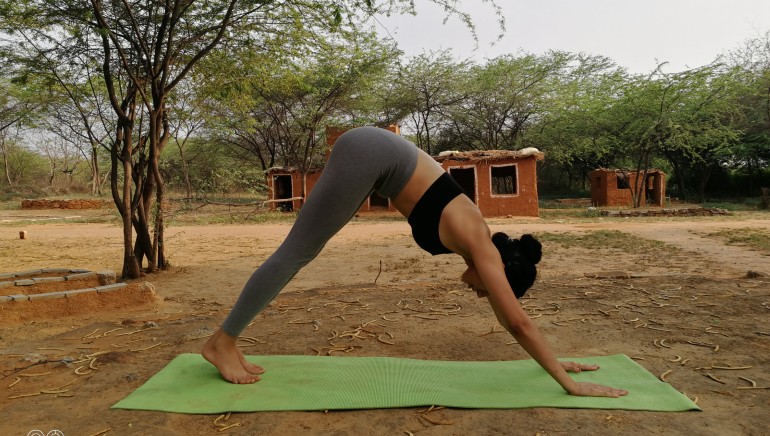
Say goodbye to tight hamstrings with these yoga poses
7 months ago | 98 Views
Tight hamstrings refer to the stiffness or restricted flexibility of the muscles located at the back of your thighs. These muscles are necessary for movement-based activities like walking, running, and bending. Tight hamstrings can limit your range of motion, causing discomfort, suffering, and injuries. It can also increase the likelihood of injury to the muscles and contribute to muscular imbalances that can cause lower back and knee pain. Thankfully, there is yoga for tight hamstrings. You can do yoga poses that might help relieve discomfort, alleviate tightness, and improve flexibility in your hamstrings.
What are the causes of tight hamstrings?
Here are some of the causes of tight hamstrings -
1. Prolonged sitting
If your job requires you to sit for long periods, it may lead to tight hamstrings due to a shortened position of the muscles, as per a study published in the Saudi Journal of Sports Medicine. While sitting, your knees bend as your hips flex. This position shortens the hamstrings. The muscles gradually adapt to this shorter position, becoming tighter and less flexible. Also, prolonged sitting might weaken the glute muscles, which are responsible for hamstring support.

2. Muscle imbalances
Muscle imbalances are caused by an uneven distribution of strength or flexibility across opposing muscle groups. When there is an imbalance, one muscle group dominates the other, which affects joint alignment and movement patterns. This can cause compensatory stiffness in weaker or less flexible muscles, such as the hamstrings, as per a study published in the Journal of Visualized Experiments. To maintain optimal performance and avoid injuries, it is critical to have a balance of strength and flexibility amongst different muscle groups.
3. Overuse injuries
“Overuse injuries arise when muscles, tendons, or other tissues are repeatedly stressed without enough healing time. Running, sprinting, and various sports can all result in overuse injuries and may lead to tight hamstrings,” says yoga expert Himalayan Siddha Akshar.
It is important to listen to your body and take rest days when necessary. Proper warm-up exercises, cool-down, and stretching routines can also help prevent hamstring overuse injuries.
4. Poor posture
Sitting in poor posture, particularly slouching or hunching, can lead to a hamstring strain, as per a study published in the Saudi Journal of Sports Medicine. When you slouch, your pelvis tilts forward. This position reduces the space between your hips and knees, putting your hamstrings in a shorter position. Slouching also causes an increase in the curve of your lower back. This might cause compensatory tightness in the hamstrings as they attempt to counterbalance the increased arch.
5. Lack of flexibility
Stretching is essential for maintaining flexibility. Insufficient stretching causes stiff muscles, especially the hamstrings. Regular stretching helps to lengthen muscle fibres. Without it, the hamstrings shorten and lose elasticity, reducing your ability to move your legs easily. "Additionally, tight hamstrings are more prone to strains and tears. Stretching improves muscular flexibility and resilience, lowering the chance of injury,” explains the expert.
What are the symptoms of tight hamstrings?
Here are some common symptoms -
- Stiffness and reduced mobility: You may find it difficult to bend over or reach your toes.
- Soreness: You may feel discomfort or soreness in the back of your thighs, which might worsen with exercise.
- Cramping: Tight hamstrings can cause muscle cramps, particularly after exercise or extended sitting.
- Reduced flexibility: You may notice a decrease in your overall flexibility, reducing your ability to carry out daily tasks.
- Poor posture: Tight hamstrings can cause bad posture, such as slouching.
- Lower back pain: Tight hamstrings can pull on the pelvis, causing lower back discomfort.
Best yoga poses to alleviate tightness in hamstrings
Here are some simple and efficient yoga poses for tight hamstrings, as per the expert.
1. Standing forward bend or Padahasthasana
- Stand with feet hip-width apart.
- Exhale and hinge at the hips, folding forward.
- Let arms hang or hold opposite elbows.
- Breathe deeply, lengthening your spine on inhale, relaxing deeper on exhale.
- Hold for 5-10 breaths.
2. Downward facing dog or Adho Mukha Svanasana
- To do downward facing dog pose, start on hands and knees, then lift hips up and back.
- Press palms into the mat, and straighten arms.
- Lengthen the spine and press heels toward the floor.
- Inhale deeply, expanding chest; exhale, pressing deeper into the pose.
- Hold for 5-8 breaths.

3. Seated forward bend or Paschimottanasana
- Sit with legs extended, and spine tall.
- Inhale, raise arms overhead.
- Exhale, hinge at hips, and reach for feet.
- Breathe slowly, extending the spine on the inhale, and folding deeper on exhale.
- Hold for 8-10 breaths.
4. Reclined hand-to-big-toe pose or Supta Padangusthasana
- Lie on your back, and extend your right leg up.
- Loop the strap around the right foot and hold the ends with your hands.
- Keep the left leg pressed into the mat.
- Breathe steadily, gently pulling the right leg closer on exhales.
- Hold for 8-10 breaths, then switch sides.
5. Half split or Ardha Hanumanasana
- Start in a low lunge, right foot forward.
- Slide right foot forward, straightening leg.
- Keep hips square, and fold over right leg.
- Inhale to lengthen the spine, exhale to fold deeper.
- Hold for 5-8 breaths then switch sides.
6. Legs-up-the-wall pose or Viparita Karani
- Sit close to the wall, lie back, and extend your legs up the wall.
- Keep buttocks close to or touching the wall.
- Rest arms by sides, palms up.
- Close your eyes and breathe deeply, focusing on relaxation.
- Hold for 5-10 minutes.
Who should avoid yoga for tight hamstrings?
While these yoga poses for tight hamstrings are safe, some people should avoid it.
- People with recent hamstring injuries or tears.
- Those with severe lower back issues, especially the forward bends should be performed under a trained yoga instructor.
- Individuals with high blood pressure should avoid inverted yoga poses.
- Pregnant women, especially in later stages, should modify or avoid these poses.
- Those with glaucoma should avoid full-inversion yoga poses.
- Anyone with acute injuries or inflammation in hips, knees, or ankles should avoid them.
It is always advisable to consult with a healthcare professional or experienced yoga instructor before starting a new practice, especially if you have any health concerns or pre-existing conditions.
Read Also: How to stay active: 13 lifestyle tips to beat laziness





















